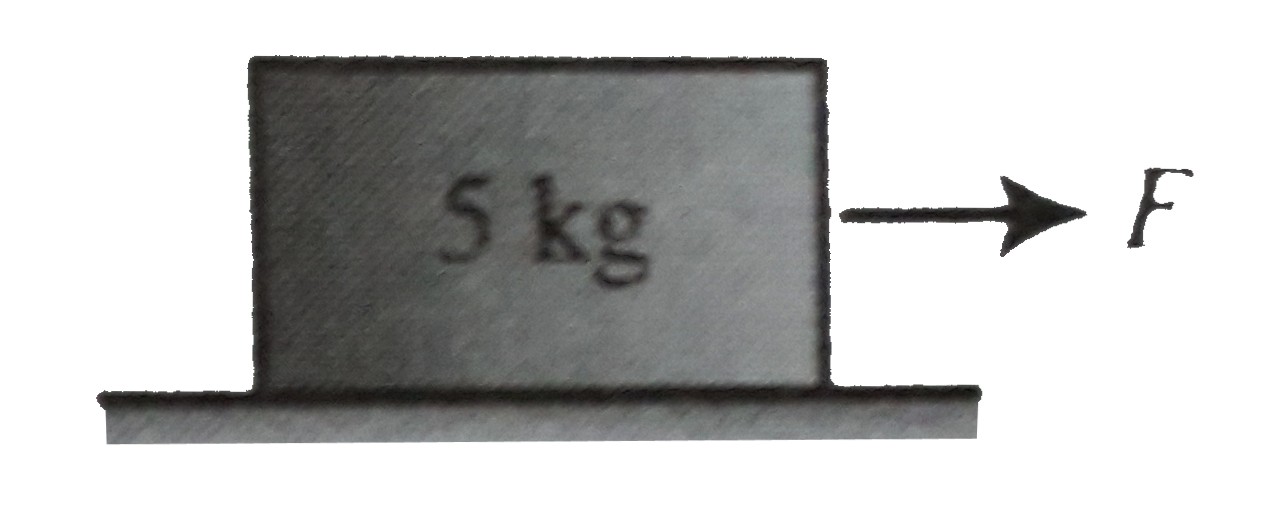A block is in limiting equilibrium on a rough horizontal surface. If the net contact force is √3 times the normal force, the coefficient of static friction is
√2
1√2
0.5
1√3
The correct Answer is:A
To solve the problem, we need to find the coefficient of static friction (μ) given that the net contact force is √3 times the normal force (N).
1. Understanding the Forces:
- The block is in limiting equilibrium on a rough horizontal surface.
- The normal force (N) acts perpendicular to the surface, and the frictional force (F) acts parallel to the surface.
2. Expression for Frictional Force:
- The frictional force can be expressed as:
F=μN
where μ is the coefficient of static friction.
3. Net Contact Force:
- The net contact force (R) is the resultant of the normal force and the frictional force. Since the friction is acting horizontally and the normal force is vertical, we can use the Pythagorean theorem:
R=√N2+F2
Substituting the expression for F:
R=√N2+(μN)2=√N2(1+μ2)=N√1+μ2
4. Setting Up the Equation:
- According to the problem, the net contact force is given as:
R=√3N
- Equating the two expressions for R:
N√1+μ2=√3N
5. Cancelling N:
- Since N is not zero, we can divide both sides by N:
√1+μ2=√3
6. Squaring Both Sides:
- To eliminate the square root, we square both sides:
1+μ2=3
7. Solving for μ:
- Rearranging the equation gives:
μ2=3−1=2
- Taking the square root of both sides:
μ=√2
Final Answer:
The coefficient of static friction (μ) is √2.
---
- The block is in limiting equilibrium on a rough horizontal surface.
- The normal force (N) acts perpendicular to the surface, and the frictional force (F) acts parallel to the surface.
- The frictional force can be expressed as:
F=μN
where μ is the coefficient of static friction.
- The net contact force (R) is the resultant of the normal force and the frictional force. Since the friction is acting horizontally and the normal force is vertical, we can use the Pythagorean theorem:
R=√N2+F2
Substituting the expression for F:
R=√N2+(μN)2=√N2(1+μ2)=N√1+μ2
- According to the problem, the net contact force is given as:
R=√3N
- Equating the two expressions for R:
N√1+μ2=√3N
- Since N is not zero, we can divide both sides by N:
√1+μ2=√3
- To eliminate the square root, we square both sides:
1+μ2=3
- Rearranging the equation gives:
μ2=3−1=2
- Taking the square root of both sides:
μ=√2
The coefficient of static friction (μ) is √2.
Similar Questions
A block is sliding on a rough horizontal surface. If the contact force on the block is √2 times the frictional force, the coefficient of friction is
View SolutionA wooden block of mass M resting on a rough horizontal surface is pulled with a force T at an angle q to the horizontal. If m is coefficient of kinetic friction between the block and the surface, the acceleration of the block is
View SolutionA block of weight 100N is lying on a rough horizontal surface. If coefficient of friction 1/√3. The least possible force that can move the block is
View SolutionA block weighing 20N rests on a horizontal surface . The coefficient of static friction between the block and surface is 0.4 and the coeffiecient of kinetic frictioni 0.20
a.How much is the friction force excerted on the block?
b. How much will the friction force be if a horizontal force of 5N is exerted on the block?
c. What is the minimum force that will start the block in motion ?
d. What is the minimum force that will keep the block in motion once is has been started ?
e. If the horizontal force is 10N what is the friction force?
View SolutionA block is kept on a rough surface and applied with a horizontal force as shown which is gradually increasing for zero. The coefficient of static and kinetic friction are 1/√3 then

View SolutionIf the normal force is doubled and limiting frictional force is maintained at the same value, the coefficient of friction
View SolutionA block of mass 5kg rests on a rough horizontal surface. It is found that a force of 10N is required to make the block just move However , once the motion begains, a force of only 8N is enough to maintain the motion find the coefficient of kinetic and static friction between the block and the horizontal surface

View SolutionA block of mass 5kg rests on a rough horizontal surface. It is found that a force of 10N is required to make the block just move However , once the motion begains, a force of only 8N is enough to maintain the motion find the coefficient of kinetic and static friction between the block and the horizontal surface

View SolutionA block of weight 200N is pulled along a rough horizontal surface at constant speed by a force 100N acting at an angle 30∘ above the horizontal. The coefficient of friction between the block and the surface is
View SolutionA block of mass 10 kg is placed on the rough horizontal surface. A pulling force F is acting on the block which makes an angle θ above the horizontal. If coefficient of friction between block and surface is 43 then minimum value of force required to just move the block is (g=10ms2)
View Solution
